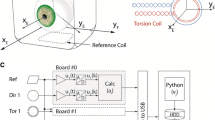Abstract
The paper describes a newly developed method, called IRIS, for the precise measurement of horizontal and vertical eye movements. The method is based on the principle of reflection of infra-red light by the iris/sclera boundary. IRIS combines, when the frequency bandwidth is from DC to 100 Hz, a dynamic measuring range of 30° with a low noise level of 1 min of arc. The installation and application procedure of IRIS, without the need for rigid head fixation, is not complicated and does not require skilled personnel. IRIS allows for simultaneous recordings of the conjugate and disjunctive movements of both eyes, with a linear range up to 25° horizontal and 20° vertical.
Similar content being viewed by others
References
Bahill, A. T., Clark, M. R. andStark, L. (1975) Dynamic overshoot in saccadic eye movements is caused by neurological control signal reversals.Exp. Neurol.,48, 107–122.
Bollen, E., Reulen, J. P. H., den Heyer, J. C., van der Kamp, W., Roos, R. A. C. andBuruma, O. J. S. (1986) Horizontal and vertical saccadic eye movement abnormalities in Huntington's chorea.J. Neurol. Sci.,74, 11–22.
Collewijn, H., van der Mark, F. andJansen, T. C. (1975) Precise recording of human eye movements.Vision Res.,15, 447–450.
Gauthier, G. M. andVolle, M. (1975) Two-dimensional eye movement monitor for clinical and laboratory recordings.Electroenceph. Clin. Neurophysiol.,39, 285–291.
Jones, R. (1973) Two dimensional eye-movement recording using a photographic matrix method.Vision Res.,13, 425–431.
Reulen, J. P. H. andBakker, L. (1982) The recording of eye movements with double magnetic induction.IEEE Trans.,BME-29, 740–744.
Reulen, J. P. H., van Heuningen, R., Tiesinga, G. andBos, J. E. (1986) Computerised eye-movement processor for clinical applications: basic considerations and design.Med. & Biol. Eng. & Comput.,24, 209–215.
Reulen, J. P. H., Marcus, J. T., van Gilst, M. J., Koops, D., Bos, J. E., Tiesinga, G., de Vries, F. R. andBoshuizen, K. (1988) Stimulation and recording of dynamic pupillary reflex: the IRIS technique Part 2.,26, 27–32.
Robinson, D. A. (1963) A method of measuring eye movements using a search coil in a magnetic field.IEEE Trans.,BME-10, 137–145.
Yee, R. D., Schiller, V. L., Lim, V., Baloh, F. G., Baloh, R. W. andHonrubia, V. (1985) Velocities of vertical saccades with different eye-movement recording methods.Invest. Ophthalmol.,26, 938–944.
Young, L. R. andSheena, D. (1975) Survey of eye-movement recording methods.Behav. Res. Meth. & Instrum.,7, 397–429.
Author information
Authors and Affiliations
Rights and permissions
About this article
Cite this article
Reulen, J.P.H., Marcus, J.T., Koops, D. et al. Precise recording of eye movement: the IRIS technique Part 1. Med. Biol. Eng. Comput. 26, 20–26 (1988). https://doi.org/10.1007/BF02441823
Received:
Accepted:
Issue Date:
DOI: https://doi.org/10.1007/BF02441823




